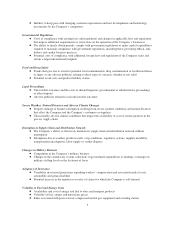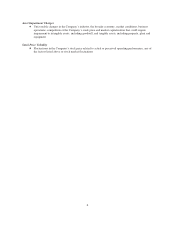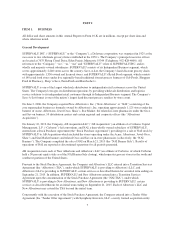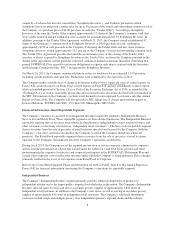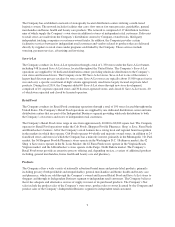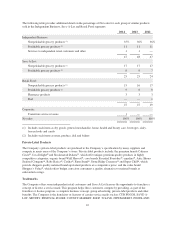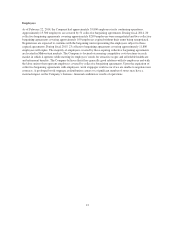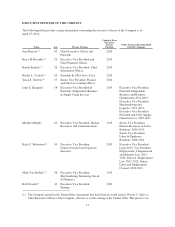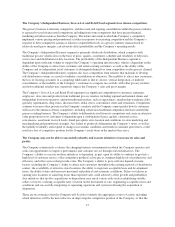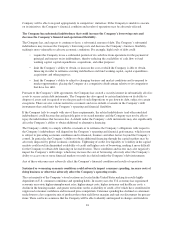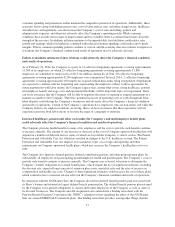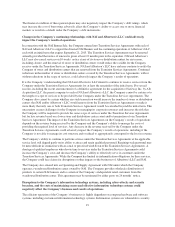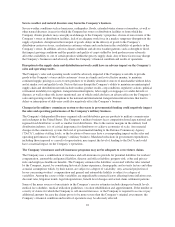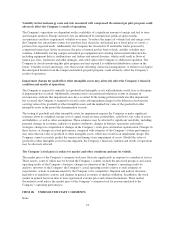Albertsons 2014 Annual Report Download - page 17
Download and view the complete annual report
Please find page 17 of the 2014 Albertsons annual report below. You can navigate through the pages in the report by either clicking on the pages listed below, or by using the keyword search tool below to find specific information within the annual report.The Company’s Independent Business, Save-A-Lot and Retail Food segments face intense competition.
The grocery business is intensely competitive, and the recent and ongoing consolidation within the grocery industry
is expected to result in increased competition, including from some competitors that have greater financial,
marketing and other resources than the Company. The nature and extent to which the Company’s competitors
implement various pricing and promotional activities in response to increasing competition and the Company’s
response to these competitive actions or failure to respond effectively, in a grocery industry characterized by
relatively small gross margins, can adversely affect profitability and the Company’s operating results.
The Company’s Independent Business segment is primarily wholesale distribution, which competes with
traditional grocery wholesalers on the basis of price, quality, assortment, schedule and reliability of deliveries,
service fees and distribution facility locations. The profitability of the Independent Business segment is
dependent upon sufficient volume to support the Company’s operating infrastructure, which is dependent on the
ability of the Company to attract new customers and retain existing customers, as well as the ability of the
Company and its independent retail customers to distinguish themselves from competitors in the grocery channel.
The Company’s Independent Business segment also faces competition from retailers that maintain or develop
self-distribution systems as a result of industry consolidation or otherwise. The inability to attract new customers,
the loss of existing customers to a competing wholesaler or due to closure, vertical integration, or industry
consolidation, or the inability of the Company’s customers to compete successfully with other grocery retailers
and non-traditional retailers may negatively impact the Company’s sales and gross margin.
The Company’s Save-A-Lot and Retail Food segments face significant competition for customers, managers,
employees, store sites and products from traditional grocery retailers, including regional and national chains and
independent food store operators, and non-traditional retailers, such as supercenters, membership warehouse clubs,
specialty supermarkets, drug stores, discount stores, dollar stores, convenience stores and restaurants. Competitors
continue to increase their presence in the Company’s markets and the Company cannot predict how its customers
will react to the entrance of these competitors, including certain non-traditional competitors that have entered the
grocery retailing business. The Company’s ability to differentiate itself from its competitors and create an attractive
value proposition for its customers is dependent upon a combination of price, quality, customer service,
convenience, assortment, in-stock levels, brand perception, store location and conditions, in-store marketing and
merchandising and promotional strategies. Any failure to positively differentiate the Company’s stores, as well as
the inability to identify and respond to changes in economic conditions and trends in consumer preferences, could
result in a loss of competitive position for the Company’s retail stores in the markets they serve.
The Company may not be able to successfully identify and execute initiatives to increase its sales and
profits.
The Company continuously evaluates the changing business environments in which the Company operates and
seeks out opportunities to improve performance and customer service through selected initiatives. The
Company’s ability to execute on these initiatives is dependent, in part, upon its ability to continue to provide a
high level of customer service, offer competitive products at low prices, maintain high levels of productivity and
efficiency and offer services that provide value. The Company’s ability to grow will also depend on many
factors, including the Company’s ability to attract new customers throughout the existing network of distribution
centers, the availability of attractive store locations, the ability to negotiate acceptable lease and development
terms, the ability to hire and train new personnel and political and economic conditions. Delays or failures in
opening new locations or achieving lower than expected sales could adversely affect growth and profitability.
Any initiatives that involve acquisitions or dispositions may entail various risks such as identifying suitable
sellers or buyers, realizing acceptable rates of return on the investment or sale, negotiating acceptable terms and
conditions and successfully integrating or separating operations and systems following the acquisition or
disposition.
There are no assurances that the Company will be able to identify the appropriate course of action, including
which initiatives will be the most effective in improving the competitive position of the Company, or that the
15


